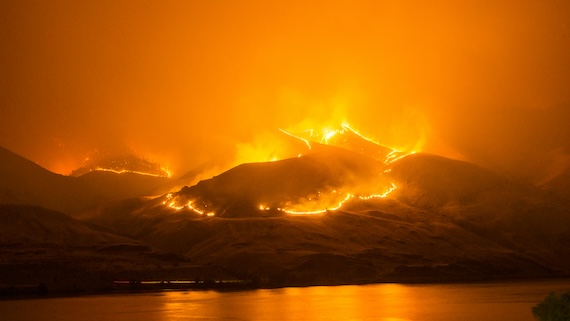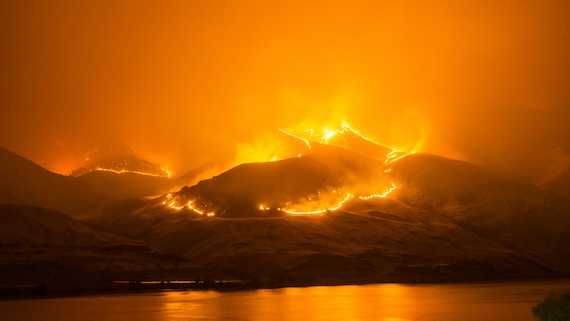Are we doomed? The short answer is: maybe not.
As we all know, humanity is facing a climate breakdown. It’s clear that we are in the early stages of a global catastrophe – and one that will happen, not some time in the distant future, but is impacting all of us, right now. What is also clear is that the situation will continue to deteriorate because we are doing very little to reduce the chances of avoiding – or at least mitigating – this disaster.
The key indicator of the crisis is the continuing rise in global temperatures – in 2024, the average temperature was 1.6C above preindustrial levels because of the El Nino. We won’t breach 1.5C for some years as a long-term average, but that turning point looms. The horrific wildfires that have occurred in California and around the world are harbingers of even greater climate disasters to come.
According to Dr. John Millar (former Provincial Health Officer in British Columbia, Canada), the disasters which result from increasingly
“…more wildfires, heat domes, droughts, floods, storms, hurricanes, melting permafrost, glaciers and sea ice, rising sea levels, and loss of species and biodiversity.”
In addition to rising CO2 emissions, there are many other ways in which we are polluting and destroying the very nature on which all life depends. The costs of these disasters, which are passed on to the population as a whole, are known to economists as “externalities”, because the corporations which create them (such as industrial agriculture, clear-cutting forests, overfishing the oceans, and so on) do not have to pay for the damage that they cause to our environment and to humanity. Rather, these costs are “externalized” to people and the natural world.
One of the most serious of these externalities is the reduction in agricultural production, especially in poorer countries. Deforestation, such as in the Amazon rain forest, reduces both the ability of nature to absorb carbon from the air, and the amount of oxygen that trees and other plants release into our atmosphere. Destruction such as this are raising temperatures, leading to Increased global hunger and death – which is forcing tens of millions of desperate people to migrate from their uninhabitable homelands. Such displacement will lead to more wars and conflicts, both within and between countries.
And inequality continues to increase. According to Oxfam, between 2020 and 2024, the richest five people in the world “have doubled their fortunes. During the same period, almost five billion people globally have become poorer.”
Growing inequality is a major part of the problem. Not surprisingly, it is the richest people who can afford to consume the most “stuff” and who also indulge in the most environmentally costly activities – such as travelling in private jets and yachts, throwing elaborate parties, and building huge estates.
Nevertheless, despite the growing amounts of carbon dioxide in the atmosphere, the corporate media (and the fossil fuel industry) have convinced much of the public that global CO2 emissions are actually being reduced, thanks to the increase in solar and wind technology, electric vehicles, heat pumps, and other forms of “green” energy.
Unfortunately, the truth is just the opposite. William E. Rees, (Faculty of Applied Science, UBC), has pointed out that, in fact,
“…globally the situation is worse, since demand for energy is increasing faster than renewables can be brought onstream, so the difference is being made up with increasing fossil fuel use.”
Rees, a pioneer in the field of human ecology, is probably best known for creating the concept of the “ecological footprint” – an estimate of the biologically productive land and sea area needed to provide renewable resources that a given population consumes, as well as to absorb the wastes that they generate. At the current rate of resource demands, it would take 1.7 “Earths” to sustain human consumption.
Unfortunately, another problem with renewables is the ecological costs of mining for the rare earth elements, like lithium, that are necessary for this technology to become widely available.
Our dilemma is obviously unsustainable and is only getting worse. Rees emphasizes that, “The transition to renewable energy (globally especially) is not happening as fast as the demand for energy increases. The only sure way to reduce emissions and global ecocrisis generally (overshoot) is greatly reduced consumption — simpler lifestyles and smaller populations.”
The critical question, then, is how do we significantly reduce ecological destruction at the same time as we reduce global poverty?
A fundamental starting point is to understand that the primary driving force of the ecocrisis is the insatiable greed of industrial and financial capitalism for profit and therefore, growth. John McMurty (Professor Emeritus of Philosophy, University of Guelph) explains in his, “The Cancer Stage of Capitalism” , that the global economic system is based profit above all else and, like cancer, it will grow and grow until it destroys itself as well as its host. (As pro-capitalist guru Milton Friedman explained, corporations have no objective other than to make as much money as possible for their shareholders).
And as Joel Bakan’s classic book and documentary, The Corporation, argued, there are significant parallels between the behavior of large corporations and that of psychopaths.
For example, the president has been loudly boasting that his policy toward the fossil fuel industry is, “Drill Baby Drill!”. and he has announced plans to dismantle the nation’s leading disaster response agency, the Federal Emergency Management Agency (FEMA), by October 1. He is also targeting efforts by states to reduce greenhouse gases, attacking the U.S. national park system, and doing all that he can to enrich the wealthy elites.
Photo by Frank Cone: https://www.pexels.com/photo/wild-fire-on-mountains-2323799/
So, given the power of large corporations economically, politically, and ideologically, what can we do to curb their power before humanity passes the point of no return?
To start with, we can keep in mind the words of the San Francisco detective played by Humphrey Bogart in, The Maltese Falcon: “It’s not always easy to know what to do.”
And the Greek physician Hippocrates stressed an approach that is as vital to social movements as it is to medicine: “First, do no harm.”
One implication of this maxim is that any solutions that we devise must prioritize the needs of the majority of people over that of the upper classes. Taxing back the wealth that they have stolen from their workers and their communities would more than cover the costs of an ecological “New Deal”.
Second, we need to create inclusive, mass democratic social movements, which are essential if we are to roll back the ecological and technological forces that are creating this existential crisis. As Social Ecologist Murray Bookchin understood over half a century ago, there are no individual solutions when it comes to taking on the power of the ruling classes – and each one of us can find a way to contribute that fits our particular situation.
More recently, Erica Chenoweth (Harvard), has shown that, in the 20th century, an amazing 53% of nonviolent campaigns succeeded in their political goals. Every one of these campaigns which had active participation from at least 3.5 percent of the population succeeded, and many succeeded with even less support. Of course, almost every campaign had a majority of the population who supported – or at least did not oppose – the movement. The key factor, however, was having at least 3.5 percent of the population actively involved in the movement, using a host of non-violent tactics, including public education, boycotts, marches, electoral campaigns, and so on.
And the goal of these movements? Rees explains that, “On a finite planet already in overshoot, it is not biophysically possible to raise the material standards of the poor to those of the rich sustainably – i.e. without destroying the ecosphere, undermining life support functions and precipitating the collapse of global society…”
Instead, “the world community should cooperate on redistribution, on devising methods to share the benefits of development more equitably.”
If not, he warns, “collapse is inevitable”.
It’s up to us.




 © 2025 All Rights Reserved
© 2025 All Rights Reserved